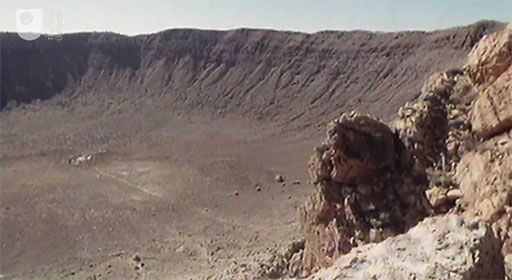2.6 Gene Shoemaker at Meteor Crater
And here is the late Gene Shoemaker himself, speaking at Meteor Crater in 1997, and remarking on why impact craters are so much better preserved on the Moon than on the Earth.
Download this video clip.Video player: moons_1_vid022.mp4


Transcript
GENE SHOEMAKER
Well, this crater was the first meteorite crater in the world that was shown to be a meteorite crater. So it was extremely important in that first intellectual step to recognise that yes, indeed, very large objects do fall out of the sky and make holes in the ground.
NARRATOR
The object that formed a Meteor Crater in Arizona 50,000 years ago was a relatively small one, around 60 metres in diameter. Nevertheless, it left behind a crater more than a kilometre across and 200 metres deep.
GENE SHOEMAKER
Paleontologists are accustomed to thinking in terms of long term geologic processes affecting the evolution of life. And if you now suddenly tell them, "Well, occasionally, a stone the size of a mountain falls out of the sky and produces a global catastrophe, they just don’t like that. It’s against their scientific religion, if you will.
Maybe it looks obvious now that the craters on the Moon were formed by impact. But in fact, the vast majority of scientists who studied the Moon, astronomers in particular, at the time that I began this work thought that these craters on the Moon were probably formed by volcanoes. That had been the prevailing idea for a century before.
The beauty of going to the Moon is there’s no rain, no atmosphere to speak of. And so a crater, once formed, lasts a very, very long time. So we have a perfect record going back three and a third billion years, in which we can say, "Here is the rate at which these things have been formed", and compare that directly to the Earth.
Interactive feature not available in single page view (see it in standard view).
